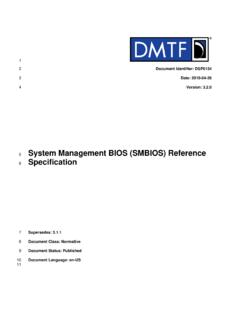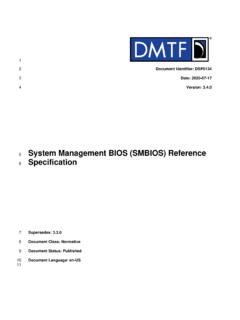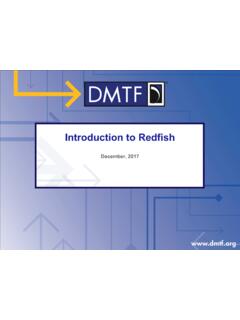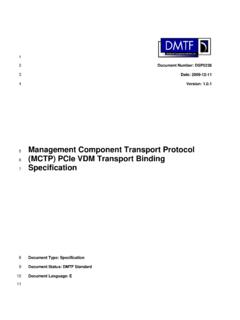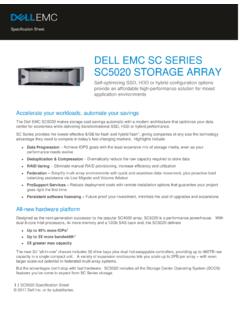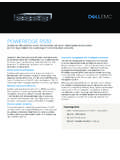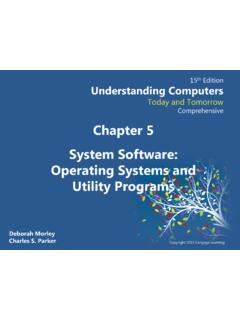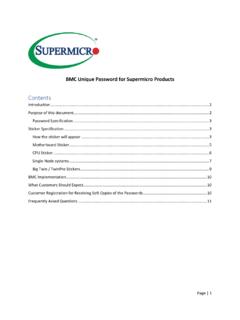Transcription of PLDM Base Specification - Distributed Management Task …
1 1 2 3 4 5 6 7 8 9 10 Document Number: DSP0240 Date: 2009-04-23 Version: platform Level Data Model (PLDM) Base Specification Document Type: Specification Document Status: DMTF Standard Document Language: E platform Level Data Model (PLDM) Base Specification DSP0240 2 DMTF Standard Version Copyright notice 11 Copyright 2008, 2009 Distributed Management Task Force, Inc. (DMTF). All rights reserved. 12 13 14 15 16 17 18 19 20 21 22 23 24 25 26 27 28 29 30 31 DMTF is a not-for-profit association of industry members dedicated to promoting enterprise and systems Management and interoperability. Members and non-members may reproduce DMTF specifications and documents, provided that correct attribution is given.
2 As DMTF specifications may be revised from time to time, the particular version and release date should always be noted. Implementation of certain elements of this standard or proposed standard may be subject to third party patent rights, including provisional patent rights (herein "patent rights"). DMTF makes no representations to users of the standard as to the existence of such rights, and is not responsible to recognize, disclose, or identify any or all such third party patent right, owners or claimants, nor for any incomplete or inaccurate identification or disclosure of such rights, owners or claimants. DMTF shall have no liability to any party, in any manner or circumstance, under any legal theory whatsoever, for failure to recognize, disclose, or identify any such third party patent rights, or for such party s reliance on the standard or incorporation thereof in its product, protocols or testing procedures.
3 DMTF shall have no liability to any party implementing such standard, whether such implementation is foreseeable or not, nor to any patent owner or claimant, and shall have no liability or responsibility for costs or losses incurred if a standard is withdrawn or modified after publication, and shall be indemnified and held harmless by any party implementing the standard from any and all claims of infringement by a patent owner for such implementations. For information about patents held by third-parties which have notified the DMTF that, in their opinion, such patent may relate to or impact implementations of DMTF standards, visit 32 33 DSP0240 platform Level Data Model (PLDM) Base Specification Version DMTF Standard 3 CONTENTS 34 35 36 37 38 39 40 41 42 43 44 45 46 47 48 49 50 51 52 53 54 55 56 57 58 59 60 61 62 63 64 65 66 67 68 69 70 71 72 73 74 Foreword.
4 5 Introduction .. 6 1 Scope .. 7 2 Normative 7 Approved References .. 7 Other 7 3 Terms and 8 Requirement Terms and Definitions .. 8 PLDM Terms and Definitions ..9 4 Symbols and Abbreviated 14 5 Conventions .. 15 Reserved and Unassigned Values .. 15 Byte 15 PLDM Data 15 UUID .. 18 Ver32 Encoding .. 18 Notations .. 19 6 PLDM Base Protocol .. 19 PLDM Message 20 Generic PLDM Completion Codes (PLDM_BASE_CODES).. 21 Concurrent PLDM Command 22 7 PLDM Messaging Control and Discovery 24 PLDM Terminus .. 24 GetPLDMV ersion .. 25 GetPLDMT ypes .. 27 8 PLDM Messaging Control and Discovery Examples .. 28 ANNEX A (Informative) Change 31 Figures Figure 1 Generic PLDM Message 20 Figure 2 Example of Multipart PLDM Version Data Transfer Using the GetPLDMV ersion 29 Figure 3 PLDM Discovery Command 30 Tables Table 1 PLDM Data 15 Table 2 Example UUID 18 Table 3 PLDM Message Common 20 Table 4 Generic PLDM Completion Codes (PLDM_BASE_CODES).
5 22 Table 5 Timing Specifications for PLDM 23 Table 6 PLDM Messaging Control and Discovery Command 24 platform Level Data Model (PLDM) Base Specification DSP0240 4 DMTF Standard Version Table 7 SetTID Command 25 75 76 77 78 79 80 Table 8 GetTID Command 25 Table 9 GetPLDMV ersion Request and Response Message 26 Table 10 PLDM Representation of 26 Table 11 GetPLDMT ypes Request and Response Message 27 Table 12 GetPLDMC ommands Request and Response Message 28 DSP0240 platform Level Data Model (PLDM) Base Specification Version DMTF Standard 5 Foreword 81 82 83 84 85 The platform Level Data Model (PLDM) Base Specification (DSP0240) was prepared by the platform Management Components Intercommunications (PMCI) Working Group.
6 DMTF is a not-for-profit association of industry members dedicated to promoting enterprise and systems Management and interoperability. platform Level Data Model (PLDM) Base Specification DSP0240 6 DMTF Standard Version Introduction 86 87 88 89 90 91 92 93 This document describes base protocol elements of the platform Level Data Model (PLDM) for the purpose of supporting platform -level data models and platform functions in a platform Management subsystem. PLDM is designed to be an effective interface and data model that provides efficient access to low-level platform inventory, monitoring, control, event, and data/parameters transfer functions.
7 For example, temperature, voltage, or fan sensors can have a PLDM representation that can be used to monitor and control the platform using a set of PLDM messages. PLDM defines data representations and commands that abstract the platform Management platform Level Data Model (PLDM) Base Specification Version DMTF Standard 7 platform Level Data Model (PLDM) Base Specification 94 95 96 97 98 99 100 101 102 103 104 105 106 107 108 109 110 1 Scope This Specification describes base protocol elements of the platform Level Data Model (PLDM) for the purpose of supporting platform -level data models and platform functions in a platform Management subsystem.
8 PLDM defines data representations and commands that abstract the platform Management hardware. This Specification defines the following elements: the base platform Level Data Model (PLDM) for various platform functions a common PLDM message format to support platform functions using PLDM The PLDM message common fields support the identification of payload type, message, PLDM type, and PLDM command/completion codes. 2 Normative References The following referenced documents are indispensable for the application of this document. For dated references, only the edition cited applies. For undated references, the latest edition of the referenced document (including any amendments) applies.
9 Approved References DMTF DSP0004, CIM Infrastructure Specification , 111 112 DMTF DSP0241, platform Level Data Model (PLDM) over MCTP Binding Specification , 113 114 DMTF DSP0245, platform Level Data Model (PLDM) IDs and Codes, 115 116 IETF RFC4122, A Universally Unique IDentifier (UUID) URN Namespace, July 2005 117 118 ANSI/IEEE Standard 754, Standard for Binary Floating Point Arithmetic, 119 120 121 Other References Hewlett-Packard, Intel, Microsoft, Phoenix, and Toshiba, Advanced Configuration and Power interface Specification , ACPI, September 2, 2004, 122 123 Intel, Hewlett-Packard, NEC, and Dell, Intelligent platform Management interface Specification .
10 Second Generation , IPMI, 2004, 124 platform Level Data Model (PLDM) Base Specification DSP0240 8 DMTF Standard Version ISO/IEC Directives, Part 2, Rules for the structure and drafting of International Standards, 125 126 127 OMG, Unified Modeling Language (UML) from the Open Management Group (OMG), 128 129 130 131 132 134 135 137 138 140 141 142 144 145 146 148 149 151 152 154 155 157 158 159 161 162 163 3 Terms and Definitions For the purposes of this document, the following terms and definitions apply. Requirement Terms and Definitions This clause defines key phrases and words that denote requirement levels in this Specification . 133 can used for statements of possibility and capability, whether material, physical, or causal 136 cannot used for statements of possibility and capability, whether material.

